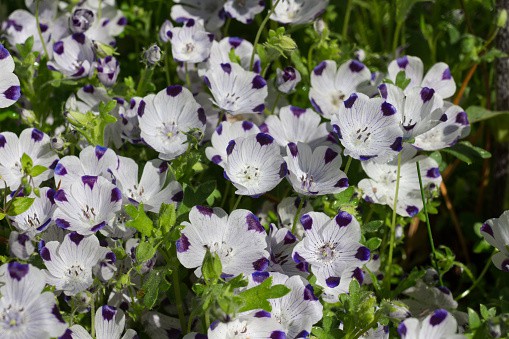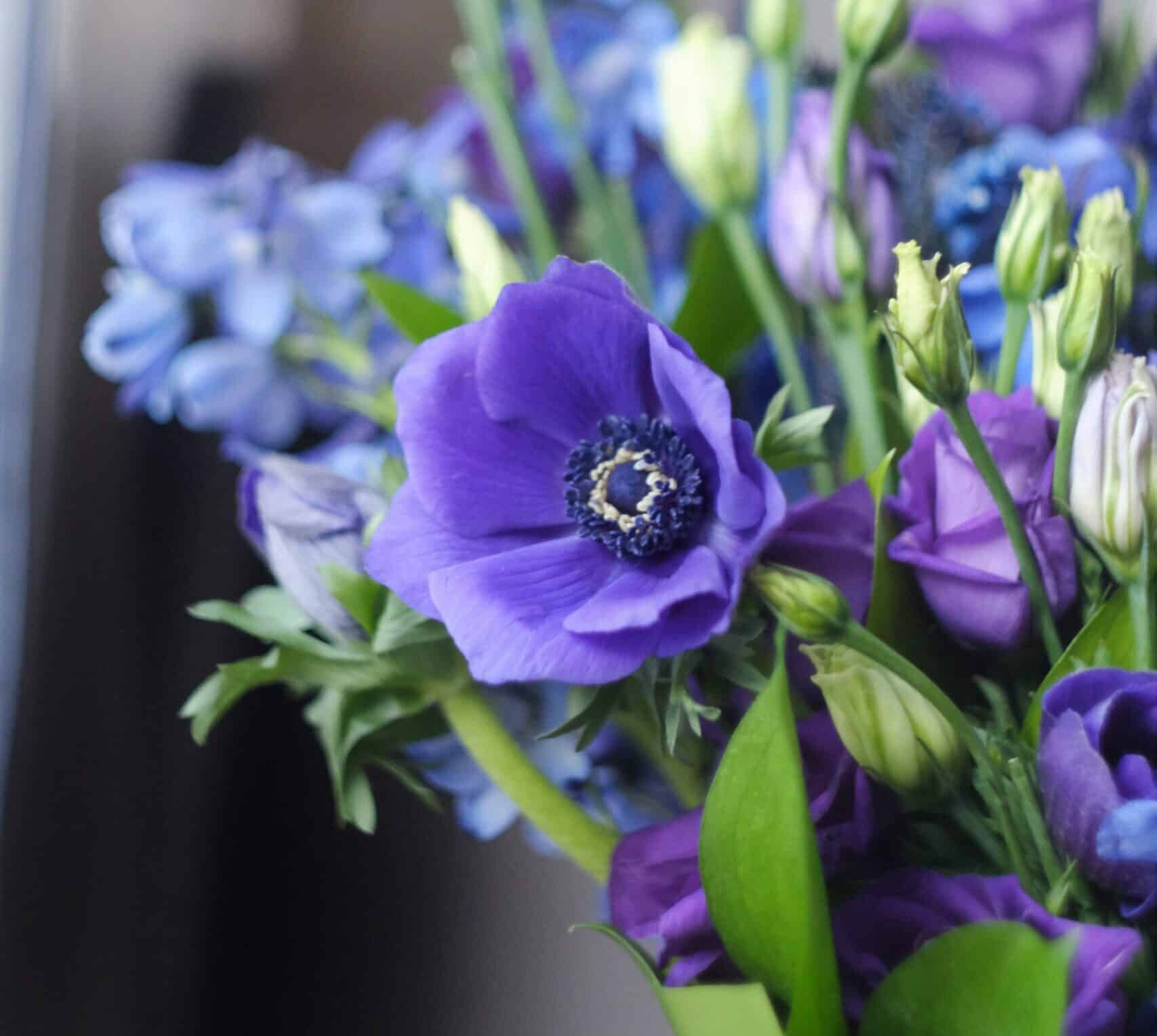Nemophila maculata, commonly known as Fivespot, is a small trailing annual that carries bowl-shaped white flowers with purple spots, thus giving it its name. This annual blooms heavily from mid-spring through to mid-summer and is irresistibly attractive to pollinators. Fivespot grows adroitly in cooler climates but does not tolerate hot or humid weather, making it an ideal flower for temperate climates. This versatile flower is great for decorating hanging baskets and can be enjoyed in zones 3 through 10.
Family
Fivespot is a member of the Boraginaceae family, colloquially known as the borage or forget-me-not family. This family encompasses a wide range of flowering plants, including over 2000 species, that span the world’s tropical, subtropical, and temperate regions. Despite the disparate species, Borage family plants usually share traits, such as clusters of blue or white flowers arranged in a star-shaped pattern with five petals. Some members of the family are grown for their edible leaves, including borage and comfrey.
Plant type
Fivespot is an annual flowering plant and, naturally, dies after the flowering season. In temperate climates, their bloom time is typically from late spring through to mid-summer. During this time, they produce unsuspecting white flowers with purple spots at the center of each petal.
Mature size
As one of the smallest members of the Boraginaceae family, Fivespot reaches heights between six to nine inches with a spread of up to 18 inches. The white flowers measure at around one inch in diameter with five purple spots at the center.
Sun exposure
Fivespot is best suited to partial shade, but can grow in full shade and full sunlight. When grown in partial shade, the flowers are brighter and more profuse; too much sun may cause the plant to dry out and shrivel up.
Soil type
Fivespot thrives in rich, moist, well-draining soil with a pH of 6.0-7.5. It is best to have the soil amended with compost that has a balance of nutrients—this helps the plant to transfer nutrients from the soil to the flower efficiently.
Bloom time
Fivespot’s bloom time is usually from late spring through to mid-summer—plants grown in cooler climates may bloom as early as late winter or early spring to mid-spring. Plants grown in very warm climates may also bloom during fall season.
Flower color
Fivespot has small white flowers with five purple spots, giving it the name “fivespot”. The flower is usually clustered in a star pattern and carries a subtle, sweet fragrance.
Hardiness zones
Fivespot grows best in temperate climates with average temperatures. It is hardy in zones 3 through 10, but may not tolerate hot or humid weather.
Native area
Nemophila maculata is native to the western parts of North America and can be found growing wildly in the wild in large parts of Canada and the United States.
How to plant
Fivespot can be planted either outdoors or indoors. When choosing an area for your Fivespot, make sure that the area receives partial shade, as too much sunlight might damage the flowers. The soil should be moist and well-draining, and you may add compost to increase the nutrient content. Plant the Fivespot in the same depth as it was at its previous location.
Meaning and symbolism
From time immemorial, Fivespot has played an important role in folk superstition and mythology. In the Greek epic, The Odyssey, Circe offers Fivespot to the blinded beggar, Polyphemus as a remedy for healing. The flowers are also seen as a symbol of freedom, beauty, and hope.
History, mythology, and religious significance
Fivespot has been used in traditional medicine and spiritual practices in many cultures around the world. Pillan, the Mapuche God, was believed to use Fivespot as a remedy for blindness, and Roman soldiers used Fivespot to cure battle wounds. In some Christian cultures, the five purple spots signify the five wounds of Jesus Christ. The Cherokee of North America associated Fivespot with peace and prosperity. Fivespot could also be found in various poems of Rabindranath Tagore, a renowned Indian poet, philosopher, and Nobel laureate who believed in the power of words.
Flower varieties and their defining characteristics
There are several varieties of Fivespot that differ in flower color, size, and shape. Some of the common varieties are:
- Nemophila maculata ‘Scopea’: This variety has purple-veined white flowers with five deep purple spots, giving them an eye-catching contrast.
- Nemophila maculata ‘Spotless White’: As its name suggests, this variety has pure white flowers with no purple spots.
- Nemophila maculata ‘Samoa Blue’: This variety has large flowers with sky-blue centers and white edges. The flowers have a slight blue hue, making this variety stand out from the rest.
How to pot and repot
Fivespot can be repotted while it is in bloom or shortly afterwards. Add compost to the potting mix and ensure that the pot is well-draining before repotting. Make sure to place the plant at the same depth as it was before, then gently water the plant. Once re-potted, it will take 2–3 weeks for the plant to re-establish.
How to prune
Fivespot should be pruned to remove dead, unhealthy, or damaged leaves. Likewise, you should remove damaged or dead stems from the plant. Prune your Fivespot at the beginning of the spring season to encourage new growth. It is best to use sterilized scissors, rather than those that have been used to cut other plants, as a precaution against spreading plant diseases.
How to propagate
Fivespot can be propagated from both cuttings and seeds. To propagate from cuttings, select a healthy stem and cut it just below the node. Stick the stem in either potting mix or a propagation medium and make sure it is kept moist. To propagate from seed, sow the seeds in a moist soil mix and keep the area moist and warm. Make sure the soil mix is kept moist until the seedlings germinate, then feed the seedlings with a steady flow of fertilizer throughout the season to encourage flowering.
Common pests and diseases
Fivespot is generally not prone to pests or diseases, but they may be affected by fungal diseases or slugs. To avoid this, make sure to keep the area free of standing water and well-draining. The plants can also be affected by aphids, but these can be avoided by regularly grooming and picking off the insects. Keep an eye on the plants and make sure to take the necessary action if any infestation is noticed.
Three frequently asked questions about Nemophila maculata
- What is the best time to plant Fivespot?
The best time to plant Fivespot is in either late winter or early spring, when the soil has warmed up and the winter chill has passed. - When should Fivespot be pruned?
Fivespot should be pruned at the beginning of the spring season to encourage new growth. - What kind of soil should Fivespot be planted in?
Fivespot should be planted in rich, moist, well-draining soil with a pH of 6.0-7.5. The soil should also be amended with compost, which balances nutrients and helps plants take in nutrients more efficiently.
A table fact sheet, with data
| Fivespot | Nemophila maculata |
| Family | Boraginaceae |
| Plant Type | Annual |
| Mature Size | 6-9 inches (height) 18 inches (spread) |
| Sun Exposure | Partial shade to full sunlight |
| Soil Type | Rich, moist, well-draining |
| Soil pH | 6.0-7.5 |
| Bloom Time | Mid-spring to mid-summer |
| Flower Color | White with purple spots |
| Hardiness Zones | 3 through 10 |
| Native area | Western North America |
What we love from Amazon this week
Buy these wonderful flowers directly from Amazon:















